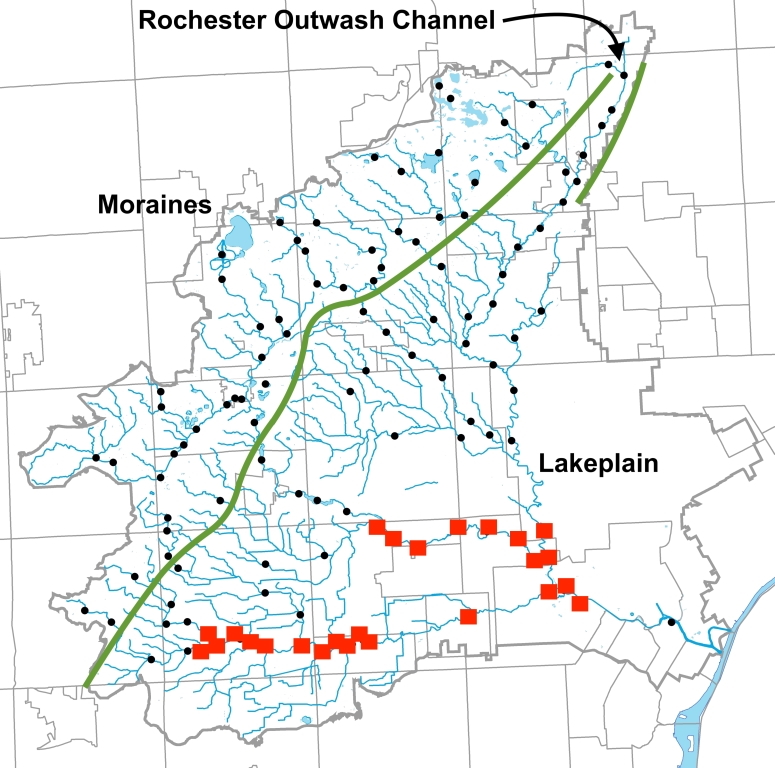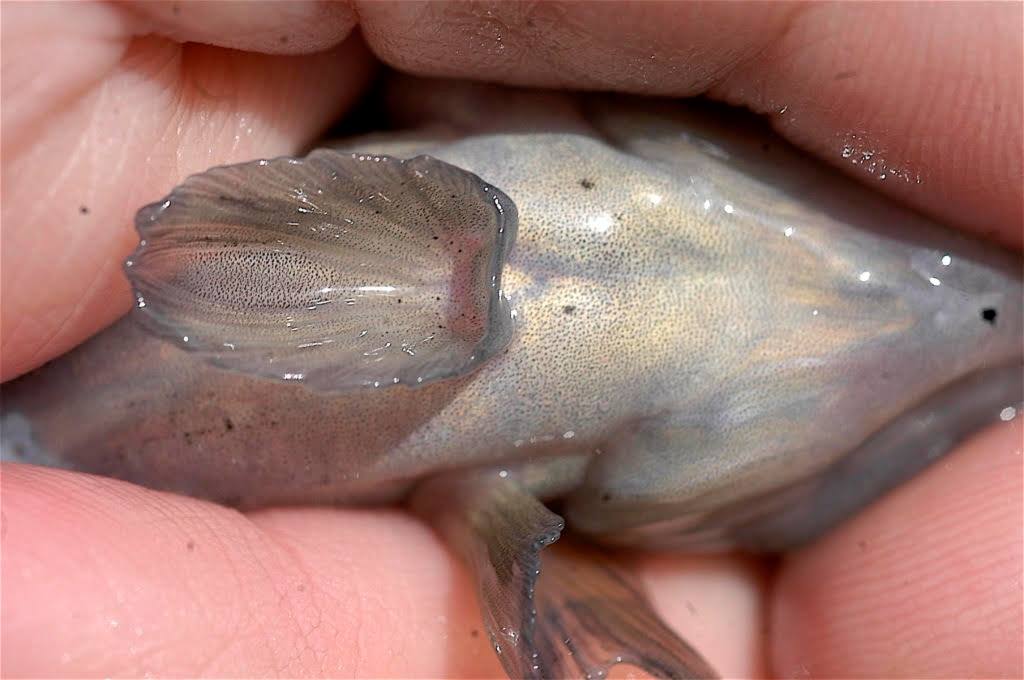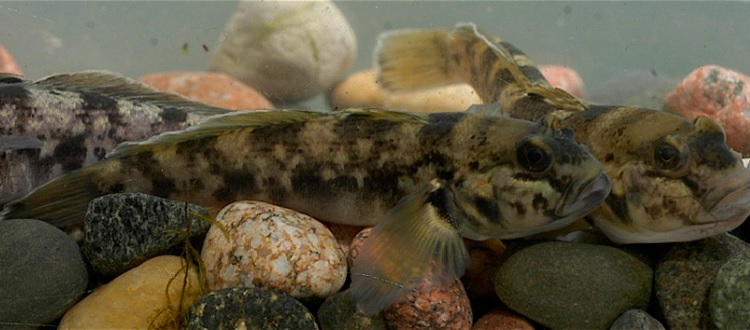An Unwelcome Imposter
GET TO KNOW round goby
Due to its general appearance (about 4 – 10 in. with tan / black mottled coloring), the round goby is often mistaken for the native mottled sculpin. Unfortunately, the round goby (Neogobius melanostomus) is an invasive and aggressive fish that is native to the Black and Caspian Seas.
(NOT SO FUN) FACT: The round goby has been one of the most aggressive of species to invade the Great Lakes. It successfully colonized all five of the Great Lakes within 5 to 6 years of its initial introduction to the Detroit River. It has also gained a strong presence within the rivers and streams in the Great Lakes basin watershed and is moving farther upstream every year.
It made its way into the Rouge from the Detroit River where it was unintentionally introduced (around 1990) through ballast water exchanges from ocean going ships. This goby, though small in size, is a formidable competitor for territory and resources, and its ever-growing presence is upsetting the natural balance of our watershed ecosystem.
For many years, round gobies were prevented from migrating upstream in the Rouge by the presence of several dams on the river. In 2012, the Wayne Road dam was removed from the Lower Rouge branch in conjunction with a river restoration project. The dam removal improved the natural flow of the river and helped restore migration/breeding patterns for native fish. Unfortunately, the project also had the unintended consequence of aiding the upstream spread of the round goby.
EFFECTS OF THE ROUND GOBY INVASION
Lower Branch
FOTR and affiliated research teams have been specifically monitoring the migration of the round goby since 2013. An initial two-year study (2013 – 2015) found that: 1) round gobies quickly develop a dominant population percentage, and 2) specific native species experience a corresponding significant population decline. Before dam removal, no round gobies were found upstream of the dam in the lower Rouge. Within the two-year scope of the study, the round goby’s percentage share grew to be 46% of the sampled fish populations. During the same time period, the most significant declines were observed in the johnny darter and creek chub populations. The johnny darter’s percentage share dropped from 19% to 4%, and the creek chub’s percentage share fell from 15% to 7%. Additionally, the study indicated that round gobies had moved a total of 16 km (approximately 10 miles) upstream from the Wayne road dam site.
A 2017 follow-up study found that the round goby had spread an additional 7 km (approx. 4.4 miles) upstream, and that johnny darter populations had declined 90% in some locations since the 2012 removal of the dam. Because the interactions between species are so complex, it may take years to learn the full impact of such a massive decline in a particular native animal.
Middle Branch and up the Main Branch
Although the dam at Fair Lane Estate would prevent round gobies from migrating upstream into the three other branches of the Rouge (the Lower is not constrained by the Fair Lane Estate Dam), round gobies were introduced into the Middle Rouge. In 2014, FOTR found them near Nankin Mills. Given that this is an area frequented by people who fish, bait bucket release is the most likely cause.
Since then, round gobies moved all the way downstream to the confluence with the Main Rouge and are now moving upstream on the Main Branch. On the Main Branch, they have now been found as far as Rouge Park. A fishway is being added around the Fari Lane Dam that will allow native fish to head upstream as well as more round gobies.

KEYS TO INVASIVE SUCCESS
Round gobies enjoy many characteristics that help them spread and colonize.
Vigorous & Bold: Round gobies are vigorous fish that are capable of surviving poor water conditions (including cold temperatures, high silt content, and low oxygen levels). They are also aggressive and bold fish. FOTR (& other) studies found that larger individuals actively explore and push the boundaries of the range.
Structure of pelvic fins: Round gobies lack a swim bladder, and movement is characterized by an alternating pattern of bottom rests and short swim bursts. Unlike native sculpins and darters, the gobies have fused pelvic fins that act like a suction cup. This gives the gobies a stronger ability to cling to rocks in faster currents and a migratory advantage for moving upstream against the current.

Breeding Cycles and parental care: Female round gobies are capable of breeding every 18 – 20 days during the spring/summer season and may lay as many 5,000 eggs each time. Eggs are deposited in rock crevices within the territory of a specific male. The male goby actively cares for the nest by fanning the water (provides a flow of fresher / more oxygenated water) and chasing away potential predators. Due to this parental care, eggs have an extremely high hatch rate (estimated at 95%).
Males continue to defend newly hatched fry until they swim away from the nest. (Note: the male round goby becomes much darker – almost completely black – during mating season.)

Domination over breeding grounds: Male round gobies actively chase fish of other species away from the best breeding sites. This practice may hinder the breeding success rate of competing native species.
Consumption of eggs of other species: Last but not least, round gobies are known for their large appetites and their tendency to devour the eggs and fry of competing fish species.
TAKE ACTION
It is illegal in Michigan to buy, sell, or use round gobies as bait. Boating laws require all boats and water equipment to be properly cleaned before transportation between sites.
Individuals are encouraged to take care when engaging in watershed activities to prevent accidental transport of round gobies to new parts of the watershed. Never dump or transport live bait or bilge water across sites, or you will very likely help spread many harmful and invasive species.
FOTR and other conservation groups are monitoring the continued spread of this fish and looking for ways to mitigate the damage. You can help by supporting these conservation efforts.
MAIN PHOTO CREDIT; Round gobies (Neogobius melanostomus) photo from FOTR website – image cropped
